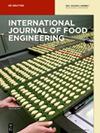马铃薯多面体对流干燥模型
IF 1.4
4区 农林科学
Q3 FOOD SCIENCE & TECHNOLOGY
引用次数: 0
摘要
摘要:本文旨在建立数值模型来预测马铃薯片在对流干燥(40-80 °C, 0.5 m·s−1)过程中的水分含量和变形。三维切片考虑圆柱,立方,平行六面体和棱镜几何。第一个经典模型将线性恒定干燥速率周期与球坐标下的菲克定律解析解耦合,计算了质量扩散系数(4.2-15.5·10−10 m2·s−1)、临界干燥时间(1640-5085 s)和临界含水量(1.8-2.4 kg·kg−1)。有限元法(FEM)是一个更稳健的模型,通过ALE方法将动量和质量传递结合到多面体的三维固体变形中,评估了质量扩散率(1.4-6.5·10−10 m2·s−1)。该有限元模型可以预测移动固体边界上水摩尔通量去除引起的收缩,并解释实验数据中检测到的准恒定干燥速率。所建立的模型准确地描述了高收缩率食品物料的干燥过程。本文章由计算机程序翻译,如有差异,请以英文原文为准。
Modelling of convective drying of potatoes polyhedrons
Abstract This work aimed to develop numerical models to predict the moisture content and deformation of potato slices during convective drying (40–80 °C, 0.5 m·s−1). Three-dimensional slices were considered in cylindrical, cubic, parallelepiped, and prism geometries. The first classic model coupled the linear constant drying rate period with the analytical solution of Fick’s law in spherical coordinates, evaluating the mass diffusion coefficients (4.2–15.5·10−10 m2·s−1), critical drying time (1640–5085 s), and critical moisture content (1.8–2.4 kg·kg−1). The Finite Element Method (FEM) was a more robust model, that combined momentum and mass transfer to three-dimensional solid deformation of polyhedrons by ALE method, evaluating the mass diffusivity (1.4–6.5·10−10 m2·s−1). The FEM model could predict the shrinkage due to water molar flux removal on moving solid boundaries and explain the pseudo-constant drying rate detected in experimental data. The developed models accurately described the drying of food materials with a high shrinkage ratio.
求助全文
通过发布文献求助,成功后即可免费获取论文全文。
去求助
来源期刊

International Journal of Food Engineering
FOOD SCIENCE & TECHNOLOGY-
CiteScore
2.50
自引率
0.00%
发文量
52
审稿时长
3.5 months
期刊介绍:
International Journal of Food Engineering is devoted to engineering disciplines related to processing foods. The areas of interest include heat, mass transfer and fluid flow in food processing; food microstructure development and characterization; application of artificial intelligence in food engineering research and in industry; food biotechnology; and mathematical modeling and software development for food processing purposes. Authors and editors come from top engineering programs around the world: the U.S., Canada, the U.K., and Western Europe, but also South America, Asia, Africa, and the Middle East.
 求助内容:
求助内容: 应助结果提醒方式:
应助结果提醒方式:


